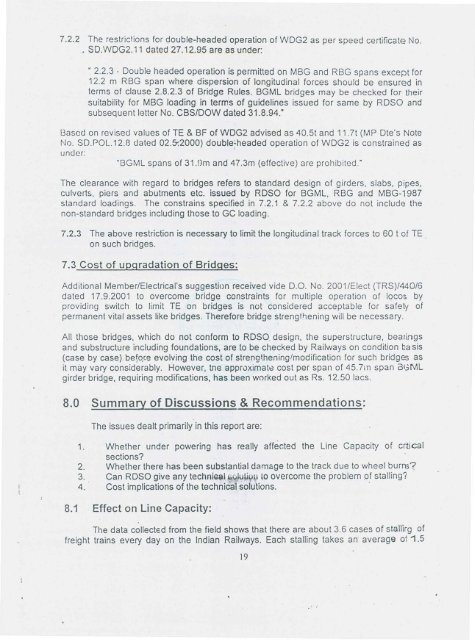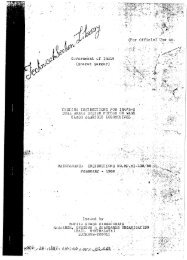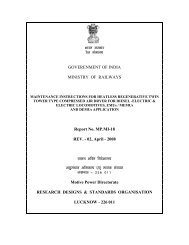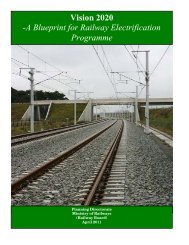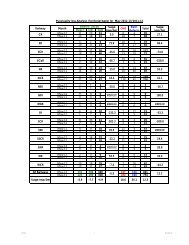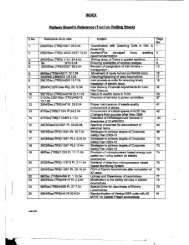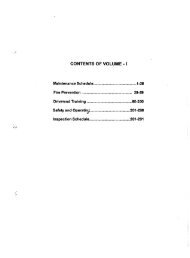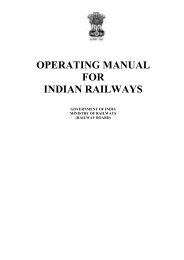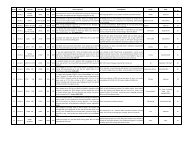RDSO's report no. TFC-77 (January 2002) of the ... - eLocoS
RDSO's report no. TFC-77 (January 2002) of the ... - eLocoS
RDSO's report no. TFC-77 (January 2002) of the ... - eLocoS
- No tags were found...
Create successful ePaper yourself
Turn your PDF publications into a flip-book with our unique Google optimized e-Paper software.
7.2.2 The restricfions for double-headed 'operation <strong>of</strong> WDG2 as per speed certificate No.H SD.WDG2.11 dated 27.12.95 are as under:~ 2.2.3 - Double headed operation is permitted on MBG and RBG spans except for12.2 m RBG span where dispersion <strong>of</strong> longitudinal forces should be ensured interms <strong>of</strong> clause 2.8.2.3 <strong>of</strong> Bridge Rules. BGML bridges may be checked for <strong>the</strong>irsuitability for MBG loading in terms <strong>of</strong> guidelines issued for same by ROSa andsubsequent letter No. CBS/DOW dated 31.8.94:Based on revised values <strong>of</strong> TE & BF <strong>of</strong> WOG2 advised as 40.5t and 11.7t (MP Dte's NoteNo. SD.POL.12.8 dated 02.&:2000) double:'headed operation <strong>of</strong> WDG2 is constrained asIunder: .."8GML spans <strong>of</strong> 31.9m and 47.3m (effective) are prollibited."The clearance with regard to' bridges refers to standard design <strong>of</strong> girders, slabs. pipes.culverts, piers and abutments etc. issued by ROSa for BGML, RBG and MBG-1987standard loadings. The constrains specified in 7.2.1 & 7.2.2 above do <strong>no</strong>t include <strong>the</strong><strong>no</strong>n-standard bridges including those to GC loading.7.2.3 The above restriction is necessary to limit <strong>the</strong> longitudinal track forces to 60 t <strong>of</strong> TE ,on such bridges.Additional Member/Electrical's suggestion received vide D.O. No. 2001/Elect (TRS)/440/6dated 17.9.2001 to overcome bridge constraints for multiple operation <strong>of</strong> locos byproviding switch to limit TE on bridges is <strong>no</strong>t considered acceptable for safety <strong>of</strong>permanent vital assets like bridges. Therefore bridge strengtf-tening will be necessary.All those bridges, which do <strong>no</strong>t conform to ROSa. design. <strong>the</strong> superstructure. bearingsand substructure including foundations, are to be checked by Railways on condition basis(case by case) befo,~eevolving <strong>the</strong> cost <strong>of</strong> streng<strong>the</strong>ning/modification for such bridges asit may vary considerably. However. tne appruximate cost per span <strong>of</strong> 45.7m span i3GMLgirder bridge. requiring modifications, has been worked out as Rs. 12.50 lacs.8.0 Summary <strong>of</strong> Discussions & Recommendations:The issues dealt primarily in this <strong>report</strong> are:1. Whe<strong>the</strong>r under powering has really affected <strong>the</strong> Line Capacity <strong>of</strong> crticalsections?2. Whe<strong>the</strong>r <strong>the</strong>re has been substantial damage to <strong>the</strong> track due to wheel burns?3. Can ROSa give any techniGsl Ll.oluU~HJ to overcome <strong>the</strong> problem Of stalling? .4. Cost implications <strong>of</strong> <strong>the</strong> techniCal solutions. .The data collected from <strong>the</strong> field shows that <strong>the</strong>re are about 3.6 cases <strong>of</strong> stallirg <strong>of</strong>freight trains every day on <strong>the</strong> Indian Railways. Each stalling takes an' average 011.519


